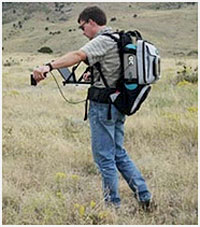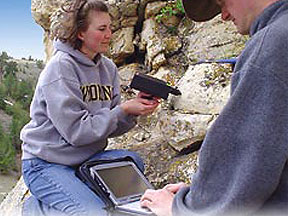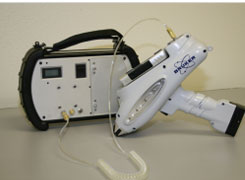Field-Portable Instrumentation
Location: MI 234
Primary Contact:
Dr. Edward Duke
The EMES maintains several instruments that can be used in a laboratory setting, but which are specifically designed for field portability. These instruments are particularly well suited for collection of field data in support of geological, ecological, or environmental studies. They also can be used to perform analyses on-site if a customer does not have the option of sending a sample for laboratory examination.
Visible and Near Infrared (Vis/NIR) Spectrometer
The Analytical Spectral Devices FieldSpec FR Pro portable visible and near infrared spectroradiometer records reflected radiation between 350 nm and 2500 nm. The system can use reflected solar radiation or an internal light source. A wide variety of organic and inorganic materials have diagnostic absorption features in this wavelength range (e.g., minerals, plants, polymers). This is also the principal spectral region of solar irradiance and corresponds with the spectral range of earth-observing satellite systems. For this reason, the portable Vis/NIR spectrometer is used extensively to provide ground-truth data for research in geological and environmental remote sensing. A second field spectrometer was acquired in 2014. It is a PANalytical TerraSpec Halo with similar capabilities to the FieldSpec Pro, but it is lighter and more compact and has an on-board GPS and mineral identification software.

Raman Spectrometer
The DeltaNu Rockhound handheld Raman spectrometer provides a portable solution for rapid, non-destructive analysis. Raman spectrometry has a wide range of applications on organic and inorganic materials including mineral identification and hazardous material identification (solid and liquid). The instrument uses a 120 mW laser source (785 nm) and operates in the spectral range 200– 2000 cm-1with a resolution of 8 cm-1. The handheld unit links via wireless blue tooth or USB connections to a laptop PC for spectral display and processing. The software includes a spectral reference library of over 500 minerals.

X-Ray Fluorescence (XRF) Spectrometer
The Bruker AXS Tracer IV-SD handheld XRF system provides rapid analysis of elements from magnesium through uranium. The handheld unit contains a rhodium X-ray source (maximum voltage of 45kV; beam current 2−25μA) and a silicon drift detector. It can be controlled through Windows CE based software on a PDA or with full lab based spectral analysis software on a laptop PC. The system includes a vacuum pump for improved detection of light elements such as magnesium and aluminum; this technology was developed in partnership with NASA for the Space Shuttle program.
X-ray fluorescence is a widely used analytical method in the geological and material sciences. The instrument can identify hundreds of standard alloys, and can detect low levels of many hazardous elements such as lead, mercury, chromium, cadmium, and bromine, which makes it valuable for screening consumer products and paint or for mapping soil and sediment contamination from industrial or mining activity.
